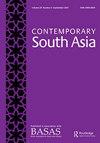当代印度的媒体话语:电视新闻研究
IF 0.8
3区 社会学
Q3 AREA STUDIES
引用次数: 0
摘要
社区和国家(以及在此之前的殖民主义者和传教士)价值体系。达斯古普塔阐述“部落”身份是一个开放的概念,涉及多个视角和动态的排序和重新排序过程,主要的棱镜是乔塔纳格布尔的Oraons及其对臭名昭著的Tana Bhagat运动的影响。与Santals、Mundas、Bhumij和Hos一样,“Oraons”也是贾坎德邦南部占主导地位的“部落”社区之一,他们在殖民想象中的刻板形象在独立前被甘地抗议文化所取代。这是通过一种新的奉献美学(巴克蒂)开始运作的,并要求一个新的代表政治。正是以阿迪瓦西的身份公开表达权利、要求和愿望的“Oraon”(或部落)政治支撑了达斯古普塔的多方面调查。这标志着一个更广泛的目标:解构,从而对在这一历史性转变中结合在一起的组成文化声音和社会主体进行细致入微的批判性描述,这一转变在独立后引起了许多当代Oran的共鸣。因此,对奥兰人农业政治(“tanas”)的内部动态和不断变化的生态以及相关的抗议和遗产运动进行了长期评估。作者是印度阿迪瓦西研究最早、最坚定的倡导者之一,这是一个多学科项目,旨在确保在高等教育背景下实现上述相互理解和尊重,这意味着这本书将引起印度土著和少数民族历史学家的兴趣,以及参与重新评估贾坎德邦等地区国家、甘地、革命、司法和历史项目重要性的社会学家和人类学家。非常有趣的是,印度人类学、法律和政治史上的重要非阿迪瓦西人物,即Sarat Chandra Roy、Mohandas Karamchand Gandhi和K.s.Singh,为这里正在考虑的阿迪瓦西和公开的Oraon世界注入了活力。出现的故事和身份同时是“部落”和土著、地区和国家。本文章由计算机程序翻译,如有差异,请以英文原文为准。
Media discourse in contemporary India: a study of television news
communities and national (and, before that, colonialist and missionary) value systems. The main prisms through which Dasgupta elucidates ‘tribal’ identity as an open concept involving multiple perspectives and dynamic processes of ordering and reordering are the Oraons of Chhotanagpur and their influential participation in the infamous Tana Bhagat movement. Alongside the Santals, Mundas, Bhumij, and Hos, ‘the Oraons’ are one of the dominant ‘tribal’ communities in southern Jharkhand, whose stereotypical presence in the colonial imaginary gave way in the preIndependence period to a culture of Gandhian protest. This became operational via a new aesthetics of devotion (bhakti) and demanded a new politics of representation. It is the overtly ‘Oraon’ (or tribal) politics of presenting rights, demands and aspirations as Adivasi that sustains Dasgupta’s multifaceted enquiry. This signals a broader objective: to deconstruct, and thereby to present a nuanced and critical account of, the constituent cultural voices and social agents that combined in this historic shift, which has assumed post-Independence resonance for many contemporary Oraons. A prolonged assessment of the internal dynamics and changing ecology of the Oraons’ agrarian polities (the ‘tanas’), and associated protest and heritage movements, therefore ensues. The author’s standing as one of the earliest and most committed exponents of Adivasi Studies in India itself a multidisciplinary project that attempts to ensure within the context of Higher Education the kinds of mutual understanding and respect outlined above means that the book will interest historians of India’s indigenous and minority peoples, as well as sociologists and anthropologists involved in reassessing the significance of national, Gandhian, revolutionary, judicial and historiographic projects in regions like Jharkhand. It is very interesting that the Adivasi and overtly Oraon worlds that are under consideration here are animated by important non-Adivasi figures within India’s anthropological, legal and political history, namely Sarat Chandra Roy, Mohandas Karamchand Gandhi and K.S. Singh. The stories and identities that emerge are simultaneously ‘tribal’ and Indigenous, regional and national.
求助全文
通过发布文献求助,成功后即可免费获取论文全文。
去求助
来源期刊

Contemporary South Asia
AREA STUDIES-
CiteScore
2.10
自引率
0.00%
发文量
82
期刊介绍:
The countries of South Asia - Bangladesh, Bhutan, India, Maldives, Nepal, Pakistan and Sri Lanka - are internally diverse and part of global flows of people, goods and ideas. Contemporary South Asia seeks to address the issues of the region by presenting research and analysis which is both cross-regional and multi-disciplinary. The journal encourages the development of new perspectives on the study of South Asia from across the arts and social sciences disciplines. We also welcome contributions to pan-regional and inter-disciplinary analysis. Our aim is to create a vibrant research space to explore the multidimensional issues of concern to scholars working on South Asia and South Asian diasporas in the postcolonial era.
 求助内容:
求助内容: 应助结果提醒方式:
应助结果提醒方式:


